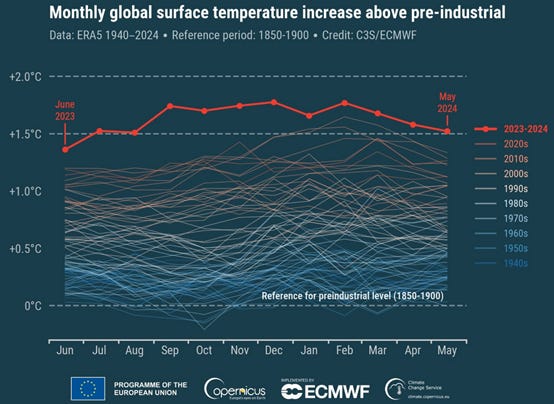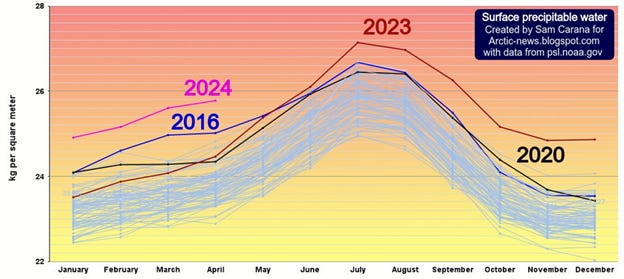Heat and Water
Intense heat waves are making water more important than ever. Humans don’t do well without it.
Image: Wikimedia Commons
“Summer is hot” isn’t exactly breaking news. These months are supposed to be hot. This summer, however, will be the hottest of modern times if recent trends continue.
Here’s the trend:
May 2024 was the hottest May since the 1940s.
April 2024 was the hottest April since the 1940s.
March 2024 was the hottest March since the 1940s.
February 2024 was the hottest February since the 1940s.
I could keep going all the way back to June 2023. In each and every one of those months, the average global surface temperature was the highest in almost a century. The last nine months it exceeded the 1.5C increase from pre-industrial times which the 2015 UN Paris Agreement set as the goal to avoid serious problems.
For now, at least, we are there. A 1.5C increase is no longer unimaginable. It’s happening.
Image: Copernicus ECMWF
This isn’t news to millions of people in Asia, which is (again) having a deadly heat wave. In Delhi, India, a weather station recorded a 52.9C (127.2F) high on May 29. That’s disturbingly close to the 54.4C Death Valley high in July 2021, which (for now) is the highest temperature ever recorded anywhere on Earth.
But Death Valley is, well, Death Valley. No one lives there. Delhi has almost 22 million residents, many of them poor with no means to escape the heat. Some can’t even get water. News photos show people holding buckets, desperate to get what they can as tanker trucks try to reach everyone.
Mexico City isn’t far behind. Heat waves combined with failing infrastructure, low rainfall and depleted aquifers have authorities saying the city will start running out of water as soon as this month.
Excess heat and scarce water are two sides of the same coin. Neither is fun and they aggravate each other.
This is partly due to simple physics. Warmer air absorbs water that would otherwise stay accessible on the surface. At higher temperatures the water raises humidity, further immiserating us, or eventually becomes rain – often a lot of rain all at once, causing floods.
The amount of “precipitable water” hit a record high last year and is doing so again this year.
Image: Jeff Berardelli
The rest is just math. The planet has a fixed amount of water. If more of it stays in the atmosphere as vapor, then our lakes, rivers and aquifers necessarily contain less.
Even if your area has a clean water supply, your access to it probably depends on electricity, the reliability of which is increasingly dubious. Even in the US, power outages of more than a few hours can shut down municipal water systems.
From there, the situation spirals quickly. Water enables civilization. Humans don’t do well without it. I had a small taste of this in the 2021 Texas winter storm and don’t want to relive the experience. I’ve since made sure we are better prepared for the next one.
What would you do if your area suddenly lost its water supply, and leaving wasn’t an option? It’s a real and growing risk.
Here’s a small, simple step: Store some bottled drinking water at home. You can handle discomfort, but without clean water you will quickly get dehydrated, sick or both. Safe water should be a top priority.
Plan on having a gallon per person, per day, for a week-long crisis. It doesn’t have to be the best spring water; just clean and securely packaged. Gallon jugs are less expensive than small bottles. Buy them now and you can both save money and avoid the crowds.
Also check out this CDC page on Making Water Safe in an Emergency. In a pinch, you can use common household bleach to purify water from unknown sources. Powdered lemonade or drink mix can improve the taste.
This is a small step almost anyone can take. If a heat wave and water crisis should find you, you’ll wish you had done a lot more.
But first you have to survive… and without water, you won’t.




